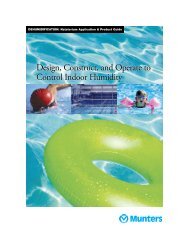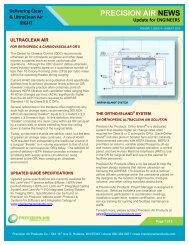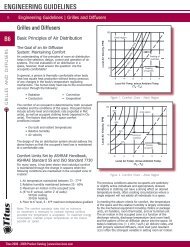Titus 2008 - 2009 Product Catalog | www.titus ... - Texas Air Products
Titus 2008 - 2009 Product Catalog | www.titus ... - Texas Air Products
Titus 2008 - 2009 Product Catalog | www.titus ... - Texas Air Products
Create successful ePaper yourself
Turn your PDF publications into a flip-book with our unique Google optimized e-Paper software.
ENGINEERING GUIDELINES<br />
B<br />
B54<br />
TERMINAL CONTROLS AND ACCESSORIES<br />
Engineering Guidelines | Terminals, Controls and Accessories<br />
Sizing Basic Terminals from Capacity Tables (continued)<br />
Sizing Parallel Fan Powered Terminals<br />
Parallel flow (variable volume) fan powered terminals are<br />
selected based on their capacity to handle the primary<br />
airflow. The same rules which apply to the selection of<br />
single duct terminals can be used, except that water coils<br />
are not in the primary airstream path, and will not affect<br />
sound levels. The pressure drop of the water coils, however,<br />
which are on the fan inlet in <strong>Titus</strong> parallel fan units, must<br />
be added to the expected discharge pressure at the fan flow<br />
rate when entering the fan curve tables.<br />
The fan is selected based on the minimum airflow<br />
requirements for the space or the heating load required.<br />
In most cases the fan can be downsized from the cooling<br />
flow requirement considerably, reducing both first cost and<br />
operating cost. The fan is selected from the fan curves.<br />
The downstream static pressure of the secondary air<br />
may not be the same as the primary air, however. If the<br />
secondary airflow requirements are less than the primary<br />
air requirements, the static pressure will be reduced. The<br />
following equation can be used to determine the static<br />
pressure at reduced airflows. (Do not forget to add water<br />
coil pressure drops to the fan requirement).<br />
Ps 1 = Ps 1 (V 1 / V 2 ) 2<br />
Where: Ps 2 = Primary <strong>Air</strong> Static Pressure<br />
Ps 2 = Secondary (Fan) <strong>Air</strong> Static<br />
Pressure<br />
V 1 = Primary <strong>Air</strong> Velocity<br />
V 2 = Secondary (Fan) <strong>Air</strong> Velocity<br />
To select a <strong>Titus</strong> parallel fan powered terminal, refer to the<br />
published fan curves and primary air pressure drop curves,<br />
together with the application and sound power data.<br />
In the parallel flow type of unit, when the primary air is<br />
ON, the fan is typically OFF, and vice versa. As shown in<br />
the Figure 86, the primary air and the fan discharge air<br />
follow parallel paths into a common plenum. Therefore both<br />
airflows will encounter the same downstream resistance at a<br />
given flow rate.<br />
Since the primary and secondary airflows come from two<br />
different sources-and often at two different specified flow<br />
rates-the volume vs. pressure relationship in each of these<br />
airflows must be checked to ensure adequate flow rates<br />
under actual job conditions.<br />
Example: Select a Model DTQP for a maximum of<br />
1400 cfm of primary air with 1.00” wg inlet static pressure.<br />
The fan airflow required is 1150 cfm. The downstream<br />
resistance offered by the duct and diffusers has been<br />
determined to be 0.30” static pressure at 1150 cfm.<br />
Primary <strong>Air</strong>: From the chart on page R46, a size 4 with a 12”<br />
inlet will handle 1400 cfm of primary air with a minimum<br />
static pressure drop of 0.22” through the primary air section.<br />
But since the downstream resistance is 0.30” at 1150 cfm,<br />
o 1400 2<br />
p<br />
1150<br />
x 0.30” = 0.44” sp<br />
<strong>Titus</strong> <strong>2008</strong> - <strong>2009</strong> <strong>Product</strong> <strong>Catalog</strong> | <strong>www</strong>.<strong>titus</strong>-hvac.com<br />
The overall primary air static pressure drop is<br />
0.22”+ 0.44”= 0.66” sp<br />
Since a 1.0” static pressure is available at the inlet, the<br />
selection will work. The damper in the primary air section<br />
Recirculated<br />
<strong>Air</strong><br />
Primary<br />
<strong>Air</strong><br />
Fan<br />
Primary<br />
<strong>Air</strong><br />
Section<br />
Figure 85. Schematic Diagram of <strong>Air</strong>flow in Parallel Flow<br />
(Variable Volume) Models<br />
Primary<br />
Secondary<br />
Either / Or<br />
Backdraft<br />
Damper<br />
Downstream Duct<br />
and Diffuser<br />
To<br />
Outlets<br />
Figure 86. Actual Arrangement of Components Shown in the<br />
Previous Schematic Diagram<br />
will do some throttling to hold the maximum air flow to<br />
1400 cfm.<br />
Secondary <strong>Air</strong> (Fan): From the fan curves, a size 4, without<br />
coils, terminal will handle 1150 cfm at 0.30” static pressure,<br />
with the proper setting of the standard SCR speed control.








